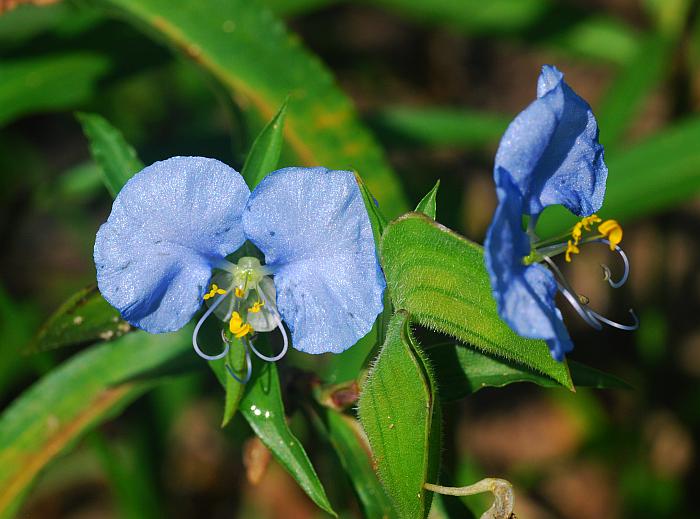Commelina erecta L.
Dayflower

Native
CC = 4
CW = 3
MOC = 57
© DETenaglia
Commelina erecta L.Dayflower | |
 |
Native CC = 4 CW = 3 MOC = 57 |
© DETenaglia |
|
Family - Commelinaceae Habit - Perennial forb with somewhat thickened, fibrous roots. Stems - Ascending to erect, to 90 cm, multiple from base, sometimes rooting at lower nodes, glabrous to sparsely pubescent near apex, often branching.
Leaves - Alternate, simple, entire, 4-15 cm long, linear to narrowly ovate, usually sparsely pubescent, sometimes somewhat glaucous on the undersurface. Leaf sheaths mostly 1-3 cm long, ciliate with white hairs, the tips extended past the attachment of the leaf blade with rounded, usually spreading auricles of tissue.
Inflorescence - Mostly near the tips of the stems, short-stalked, the folded spathelike bracts 12-25 mm long, the margins fused in the lower third, the lower edge (midrib of the bract) straight or nearly so Spathe often scabrous due short, stiff hairs.
Flowers - Sepals 3-4 mm long. Petals 3, strongly unequal, the upper 2 petals 10-25 mm long, blue, the lower petal 5-7 mm long, white. All 3 staminodes with well-developed false anthers, these 4-6-lobed, yellow, lacking a reddish brown spot in the center. Stamens 3, with one incurved and having a larger anther. Anthers yellow, 4-lobed. Filaments glabrous, pale yellow to white, to 4 mm long. Style curling at apex, to 5 mm long, glabrous, white. Ovary green, 1 mm in diameter, 3-locular.
Fruits - Capsules 4-6 mm long, 3-locular and 3-seeded. Seeds 3-4 mm long, the surface smooth to slightly granular.
Flowering - May - October. Habitat - Sand and gravel bars, streambanks, wooded slopes, bluffs, glades, roadside ditches. Origin - Native to the U.S. Lookalikes - Other members of the genus, especially C. communis. Other info. - This pretty and distinctive native species is most common in the southern half of Missouri, though probably found to some extent throughout the state. Its U.S. distribution encompasses most of the continental states except a few in the northwestern region. It is easily recognized by general appearance, though there are some closely related lookalikes. This species is defined by having two blue and one white petal, and a partially fused bract subtending the inflorescence. The bract fusion is easily disrupted, so it is best to look carefully without touching, or look for the "elbow" on the rear of the bract rather than a smooth arc (see image above). A third detail is that the false anthers on the three staminodes are entirely yellow without a central brown spot. Photographs taken in Winter Haven, FL., 6-27-02, and at Millstream Gardens Conservation Area, Madison County, MO., 7-17-04 (DETenaglia); also at Holly Ridge Conservation Area, Stoddard County, MO, 8-15-2009; Klondike County Park, St. Charles County, MO, 8-08-2011; the racetrack sand prairie, Scott County, MO, 8-30-2011; along the Katy Trail near Dutzow, Warren County, MO, 8-02-2012, 9-04-2015, and 11-03-2019; along the Katy Trail near Augusta, St. Charles County, MO, 8-03-2015; along the Katy Trail near Treloar, Warren County, MO, 10-02-2020; and at Marais Temps Clair Conservation Area, St. Charles County, MO, 7-25-2024 (SRTurner). |